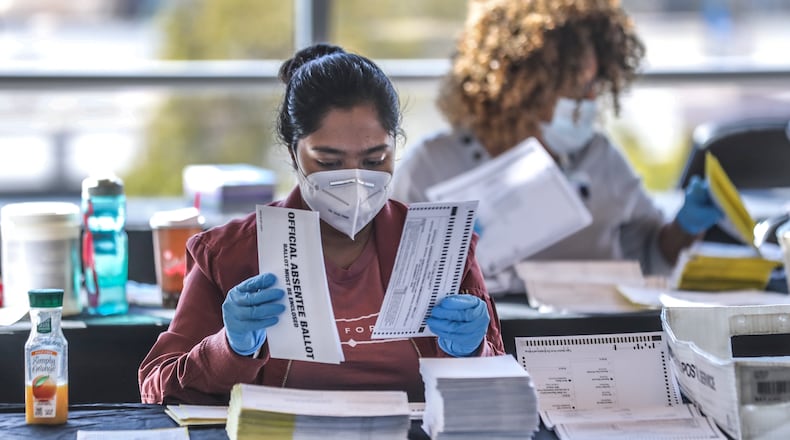Don’t trust the results of the election? For the first time, Georgia voters can check ballots for themselves.
Digital images of ballots are now public records in Georgia, available for anyone to see upon request and payment of a fee to county election offices.
A batch of 145,000 Fulton County absentee ballots cast in November’s election shows a picture of every ballot and bubbled-in oval, followed by a printed page verifying how voting machines counted each race. The Atlanta Journal-Constitution obtained the ballot images by paying a $240 records retrieval fee to Fulton County.
There are many possibilities for how these ballot images could be used — or abused.
Concerned citizens could recount ballots themselves. Candidates could identify voting patterns, such as split tickets among Democrats and Republicans. Those who believe an election was stolen could look for counting irregularities, highlighting potential errors.
Ballot images are created the moment ballots are inserted into scanners, which contain memory cards that store data. Election workers scan absentee ballots; in-person voters deposit ballots themselves. Ballots can’t be traced to the person who cast them, preserving voter secrecy.
The ability for the public to see ballots is required by Georgia’s new voting law, Senate Bill 202, which also limits ballot drop boxes, changes voter ID rules and overhauls elections operations after Republican Donald Trump lost to Democrat Joe Biden by about 12,000 votes here in the presidential election.
An initial look at Fulton’s ballot images indicates that scanners generally recorded votes correctly. When a vote was ambiguous, such as when a voter partially filled in an oval, a bipartisan review team decided on the voter’s intent, and that result is shown along with the ballot images. Recounting every ballot would require computer scanning programs or long hours of human review.
“Transparency can help people actually understand and restore confidence in elections,” said state Rep. Shea Roberts, a Democrat from Atlanta who proposed making ballot images public in a bill that was partially incorporated into Georgia’s new voting law. “There’s a lot of misinformation about the process and about what goes on, and it fuels these conspiracies.”
Skeptics of Georgia’s results in the presidential election are also seeking to inspect Fulton County ballot images through a lawsuit that alleges counterfeit absentee ballots. But they’re asking for higher-resolution images than those that are now available to the public.
Biden won Fulton with 73% of the vote, including 79% of absentee ballots.
A judge granted the request to review high-resolution ballot images, which the plaintiffs say will help them find whether there were faked “pristine” ballots, with perfectly filled-in ovals on unfolded ballots. Fulton has asked the judge to dismiss the case before the review moves forward.
Election officials have said there’s no indication of fraud on a scale that could have changed results, and ballots were counted three times, including a full recount by hand of all 5 million ballots cast statewide.
Revealing ballot images to the public could help the public understand how elections work, but images could also be digitally altered and used for disinformation, said Eddie Perez of the Open Source Election Technology Institute, which advocates for election transparency and integrity.
“If this is done well and done correctly, this could help public confidence, but it requires security, transparency and public education,” Perez said. “It could end up being used to sow doubt rather than bolster confidence in election outcomes.”
Original paper ballots will remain the source of official vote counts, and they’re kept in the government’s custody, only unsealed by a judge’s order.
Voters should understand how scanners interpret ballots and how discrepancies are resolved, Perez said.
Ballot scanners count votes if at least 10% of an oval is filled in, according to a State Election Board rule.
Ambiguous marks were flagged for human review by teams made up of a Republican, a Democrat and a nonpartisan member appointed by a county election supervisor. That adjudication panel checked the issue, such as a stray mark or votes for multiple candidates, and then a majority decided on the voter’s intent.
Groups such as the Coalition for Good Governance, an election integrity organization suing over the state’s voting system, plan to post ballot images online.
Marilyn Marks, the organization’s executive director, said ballot scanners sometimes miss counting valid votes.
“This will help us begin to know the extent of the failure,” Marks said.
The availability of ballot images is becoming more widespread because voting technology allows it.
Several other states and counties make ballot images available to the public, including in California and Colorado.
Ballot images made public
Digital images of every ballot cast in Georgia are now public records, available under a new Georgia law to anyone who requests and pays for them.
Disclosure of ballot images will allow members of the public and political operatives to check results and look for voting patterns. But some election integrity advocates warn that the images could be abused to spread misinformation.
The Atlanta Journal-Constitution recently obtained images of 145,000 absentee ballots cast in the November general election in Fulton County.
About the Author
Keep Reading
The Latest
Featured






